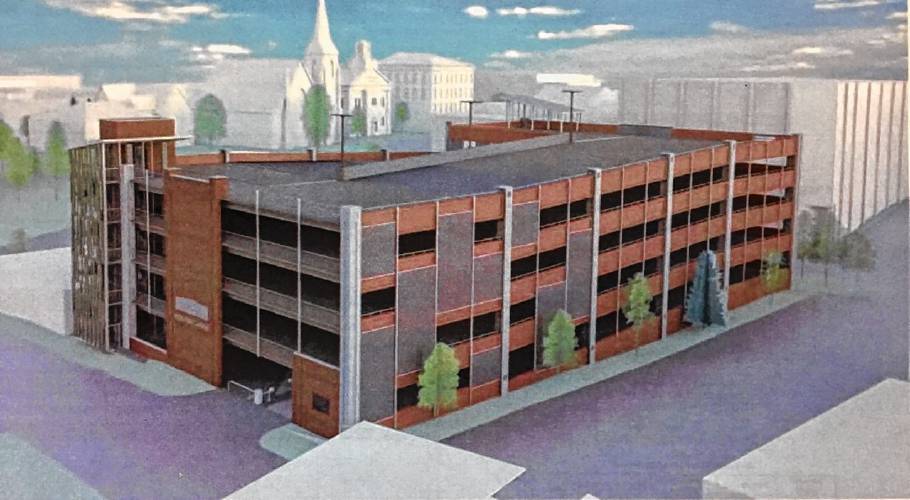Opinion: Frequently Unanswered Questions: A Municipal Parking Garage Behind CVS

Architect's rendering for the Olive Street Garage, Greenfield, MA. Photo: greenfield.ma.gov

Frequently Unanswered Questions is an occasional feature of the Indy that will pursue answers to questions about critical issues that are facing the Amherst community, and have been frequently raised but have gone unaddressed. (see here and here for past columns).
This week, we’ll look at the proposal to rezone the lot behind CVS to enable the construction of a parking garage or other stuctures there, and questions about that possible construction.
At this point, I am not taking a stand for or against a garage—or even for or against the rezoning of the lot. We might need a parking garage. And maybe we don’t. It might be prudent to rezone that lot right now to expedite development there. And it might be reckless to rush forward with the rezoning without a comprehensive exploration of the implications.
A public hearing on the rezoning was held by the Community Resources Committee on July 13. A public hearing was held by the Planning Board on July 7 and continued on August 5. A final discussion and decision by the board has been postponed until September 29. Presentations and discussion on the proposed rezoning were recently held at public meetings for residents of District 3 and 4.
At all of these events, many questions and concerns were raised. But they have mostly been ignored or were deflected by the presenters of the proposed rezoning, Councilors George Ryan (District 3) and Evan Ross (District 4).
Here is a list of some of the questions that have been raised that have gone largely unaddressed.
- What’s the rush to rezone and why undertake rezoning before we have addressed the important questions being raised?
- Does the town need a parking garage? The town has conducted three parking studies in recent years (2016, 2018 and 2019) , each of which indicated that there is no need for additional parking downtown. They indicated that instead, the town needs better signage, lighting, and maintenance of current spots, and that it should make use of opportunities that it is currently neglecting. Also, the number of people using the town portion of the lot behind CVS has been going down steadily over the past few years-suggesting that more parking is not needed or that people prefer to park elsewhere.Planning Board member Maria Chao and Councillors Ryan and Ross indicated that they have no time to consider previous studies. This seems unreasonable. How can this be justified? And if in fact, there is no demonstrable need for additional parking, why are we planning to build a garage—especially in the face of vociferous objections from abutters?
- Is the project envisioned for the lot behind CVS even feasible? And shouldn’t we figure that out before we dramatically rezone the lot on which the project might be built? See here.
- What are the implications for the lot if it is rezoned and a garage is not built there? Would this permit the construction of a five-story apartment building, and isn’t that outcome what the current zoning (RG) is designed to prevent? The proposers have assured residents of North Prospect Street that would “never” happen, but are they able to make a credible promise?
- What would be the net gain in parking spaces for the lot behind CVS if a three-story garage were to be constructed? What about a five-story garage, which would also be permitted under the proposed rezoning?
- Is the total gain in parking spaces worth the effort?
- If a deal is struck or has been struck with a private developer, how many spaces or what percentage of the total would be reserved for subscription parking…serving the residents of downtown apartments?
- Why is there no discussion of alternative sites (like the Amherst Cinema and Boltwood lots)?
- Why are we moving ahead with rezoning without a traffic study for viability of a Pleasant Street entrance and North Prospect Street exit? Can they reasonably serve a three- or five-story garage?
- Why is there no impact study examining the potential impacts of such traffic changes on the historic North Prospect Street neighborhood? Can Cowles Lane and North Prospect Street, narrow residential streets, handle the traffic from such a garage? Would street parking need to be eliminated on those streets, reducing the net gain from a garage?
- Councilor Shalini Bahl-Milne announced back in June that the Town Council was in the process of negotiating with a developer to build a garage on the CVS lot. This raises a number of important questions:
a. Who were the parties involved in the negotiations? From the presentations thus far, it would appear to be Councilors Ryan and Ross from the town. But who is/are the developer(s)?
b.Who authorized the negotiations? And why is there no public record of this?
c. What was negotiated and were any agreements reached?
d. Do these negotiations foreclose the possibility of a competitive bidding process? Is the town already committed to working with a specific developer?
e. Have these negotiations differentially and unfairly advantaged (or disadvantaged) certain parties?
f. It has been stated that the Business Improvement District (BID) group approves of the construction of a three-story garage on the lot behind CVS. What has the BID’s role been in the ongoing negotiations and what parameters have they set/requested for the project?
- While Councilors Ross and Ryan have stated emphatically that there is no plan yet, their presentations strongly suggest that there is. If the plan, as has been rumored, is to grant the land of the town lot (a 99-year lease @ $1 has been mentioned) and the revenue from the garage to a developer in exchange for building the garage—where is the analysis that demonstrates that this is a good deal for the town?
- If a garage is built, will the town or the developer set the parking rates?
- Why did the town pay $485,000 for the property in 1989 that is currently assessed at $181,900?
- Councilor Ross said in his memo of August 4 that “one potential bidder’s preliminary analysis” (elsewhere he said this was an architect with experience with parking garages) showed that 195 spaces could be accommodated in a 3-floor structure (an increase of 123 over the current town-owned portion of the lot), “with full lot coverage, which requires rezoning to BG.” But zoning rules require a 20-foot setback where RG abuts BG, which would apply to the two long sides of the lot, and a 10-foot rear setback. The math doesn’t add up—65 spaces per parking level, compared to 72 spaces that are there now with no setbacks. Is Councilor Ross assuming that these setbacks can be waived? Would there be no front setback to screen the garage from the historic district across North Prospect Street?
- Planning Board member Janet McGowan has cited a 1990 study that argued that because of limiting setback requirements on the lot (see # 14), a parking garage at that location is not financially feasible. What exactly are the limitations after rezoning, and is a project there financially feasible?
- It has been suggested that the developer supported by the BID, who owns adjoining property, is said to be only interested in this particular site (i.e. the lot behind CVS), which might explain why government representatives keep dodging when asked to undertake a comparative analysis of what could be built on other town-owned properties (e.g. Amity Street, Boltwood). Nobody seems to be empowered to ask the Bank of America whether it would consider selling or giving its lot to the town to merge with the Amity lot, in exchange for free parking for bank customers during banking hours. The two lots combined would be larger than the town-owned portion of the CVS lot, would. be nearer the cinema, Common and library, have easier access and egress, and would be located only a block away from the CVS lot. They have no residential abutters. Can anyone in government address this scenario?
- Given the town’s commitment to achieving net zero by 2050 and 50% of net zero by 2030, and given that this requires a considerable reduction in fossil fuel use, much of which must be achieved in the transportation sector, how does the town justify building a parking garage to draw more private vehicles into downtown?
- What can be learned from history to inform moving forward (including a study of the Amity Street potential site from 1997)?
- Should the voters have a say in whether public land, paid for and supported with taxpayer money, is handed over to a private developer?

Thanks for including item 17 in this litany, Art.
Please keep in mind that it’s not just about the fossil fuel used by the cars, or that more car traffic be drawn into “downtown” Amherst by another parking garage.
It’s also about the broader environmental impact of investing more and more in car infrastructure, diverting investment from public and alternative transportation choices, as well as promoting the ever-expanding “sprawl” whose impact eclipses the direct impact of any parking garage in Amherst.
We can see the impact with our own eyes, and it’s well-documented in everything from census data to the CO2 concentrations in the atmosphere, but if one needs a prophet, that would be the late Jane Holtz Kay, and the prophecy is in her book
https://www.ucpress.edu/book/9780520216204/asphalt-nation
from which even a skeptic might learn a thing to two….
Re: Q13 ( Why did the town pay $485,000 for the property in 1989 that is currently assessed at $181,900?):
The Town acquired the property from Louis Foods by a taking in 1989. I’m not quite sure why the Town paid so much for it compared to its current assessed value. Louis Foods moved out of downtown to University Drive in 1986.